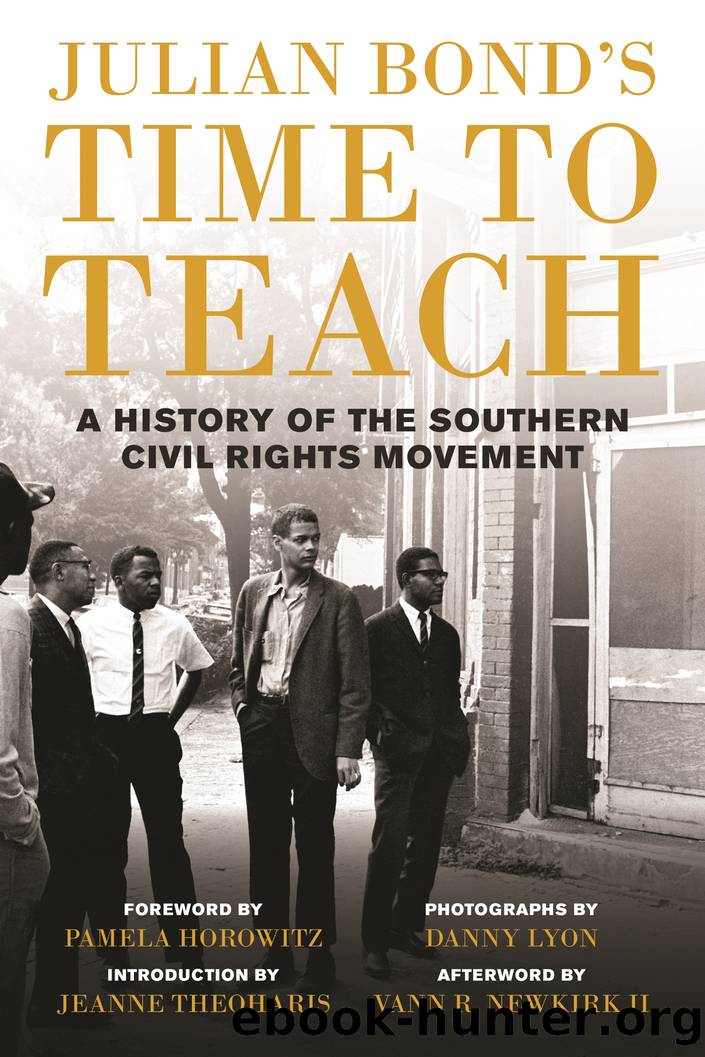Julian Bond's Time to Teach by Julian Bond

Author:Julian Bond [Bond, Julian]
Language: eng
Format: epub
Publisher: Beacon Press
Published: 2021-02-15T00:00:00+00:00
Jail officials brought tour groups from Magnolia to look at the twelve âcommunists.â When a young girl asked McDew to âsay something in Communist,â he said, âKiss mir tuchus.â
When they were released from jail after thirty-seven days on December 6, Moses found a dispirited community. Although McCombâs Black adults had rallied to the defense of their arrested children, the threats, beatings, jailings, and Herbert Leeâs death had taken their toll. Their meeting place at the Masonic Temple was closed to them; someone just missed John Hardy with a shotgun blast into his bedroom. No one would come to registration classes. With Hardy, Curtis Hayes, and Hollis Watkins, Moses left McComb for Amzie Mooreâs house in the Delta. SNCCâs first attempt at establishing a voter registration project in Mississippi was over.
The McComb experience helped to further shape SNCC from the coordinating committee it had intended to be into a staff-directed organization. The student-directed sit-in movement SNCC had been formed to coordinate was in decline, but SNCC, despite the McComb defeat, was on the ascendancy. The direct actionists had learned a valuable lesson in McComb: voter registration was direct action in small-town Mississippi. The split between the âdirect actionâ and âvoter registrationâ wings became meaningless. In the future, SNCCâs direction would be determined by actions taken and work done, not by titles and divisions. McComb helped to refine SNCCâs organizing techniques. Dependence on local leadership coupled with militancy might not have succeeded in McComb, but it could be tried again elsewhere with greater success.
The addition of Bob Zellner to SNCCâs staff made it interracial, but Zellnerâs presence meant more than that. He was hired with a grant to SNCC from the Southern Conference Education Fund (SCEF), an interracial organization formed in the 1930s. Like many interracial organizations, SCEF was a target of Southern red-baiters, especially after a field secretary, Carl Braden, refused to answer questions before the House Un-American Activities Committee and was sentenced to a year in prison for contempt of Congress. Braden and his wife, Anne, developed close ties with SNCC. SCEFâs newspaper, the Southern Patriot, printed articles about SNCCâs efforts and philosophy when the mainstream press and other liberal organizations ignored them. And the Bradens understoodâmore than most whitesâthe proper role of whites in a Black-led movement. Southern Blacks, she said, did not âwant the participation of white people if they are to be a drag on [the] movementâ or if including whites meant âthe old pattern that has often prevailed even in liberal interracial organizationsâ that of white domination.â22 SNCCâs easy acceptance of Anne and Carl Braden, who were persona non grata to every other civil rights organization, marked the beginning of a political openness in SNCC that distinguished it from the rest of the civil rights pack.
The SCEF grant was to be used to hire a white student to recruit on white campuses; John Robert Zellner was the student hired. Born in southern Alabama, the son of a Methodist preacher, he attended high school in Mobile and Huntingdon College in Montgomery.
Download
This site does not store any files on its server. We only index and link to content provided by other sites. Please contact the content providers to delete copyright contents if any and email us, we'll remove relevant links or contents immediately.
Should I Stay or Should I Go? by Ramani Durvasula(7435)
Why We Sleep: Unlocking the Power of Sleep and Dreams by Matthew Walker(6364)
Fear by Osho(4496)
Flow by Mihaly Csikszentmihalyi(4493)
Rising Strong by Brene Brown(4195)
Why We Sleep by Matthew Walker(4193)
How to Change Your Mind by Michael Pollan(4115)
Too Much and Not the Mood by Durga Chew-Bose(4097)
The Hacking of the American Mind by Robert H. Lustig(4093)
Lost Connections by Johann Hari(3929)
He's Just Not That Into You by Greg Behrendt & Liz Tuccillo(3719)
Evolve Your Brain by Joe Dispenza(3506)
The Courage to Be Disliked by Ichiro Kishimi & Fumitake Koga(3264)
Crazy Is My Superpower by A.J. Mendez Brooks(3208)
What If This Were Enough? by Heather Havrilesky(3201)
Resisting Happiness by Matthew Kelly(3197)
Descartes' Error by Antonio Damasio(3168)
The Book of Human Emotions by Tiffany Watt Smith(3145)
In Cold Blood by Truman Capote(3141)
